Scottsdale Slip and Fall Attorneys Explain When You Can Sue For a Slip and Fall Injury
Scottsdale Slip and Fall Attorneys Explain When You Can Sue For a Slip and Fall Injury
The term “slip and fall” is used to describe a broad category of cases involving injury on someone else’s property. Slip and falls usually occur when a substance or object is left on the ground of a business for an unsuspecting customer to slip or trip on. Typically, slip and fall cases are brought under a claim of “negligence” which requires the injured person to prove that the owner or maintainer of the property failed to exercise reasonable care.
Slip and fall cases are generally more difficult to advance then car accident cases. This is because slip and fall cases are usually contested aggressively by the property owner. The property owner can claim that the person who fell is fully or partially at fault for causing his or her own injuries. The property owner can also make the injured party prove that the property owner was responsible for the dangerous condition and had time to correct it. On the other hand, car accident cases usually have an easily identifiable person at fault. As a result, there are two factors to consider when thinking about brining a slip and fall case. First, the level of fault and second, the severity of the resulting injuries.
It May Be Very Difficult to Prove Fault In a Slip and Fall Injury Case
Determining fault is almost always the most challenging aspect of slip and fall cases. Courts in Arizona have decided fault based on several different factors including the legal status of the person injured, the condition that caused the injury, and the notice of the condition that was given to the property owner. In order to successfully win a slip and fall case at trial, an injured person must convince a jury that the owner or maintainer of the property owed them a duty to keep his or her property safe and breached that duty by failing to keep it safe.
…owners of property do not have to exercise the same degree of care to those who do not have permission to be on their property for a legal purpose.
The specific duty owed by a property owner is determined by the legal status of the person on the property. The first step in assessing any slip and fall case is to determine the “legal status” of the person who was injured. For example, property owners do not owe the same degree of care to those who are on their property for business purposes compared to those who are trespassing on their property. Unless you were on the on the property for a legal purpose, you will have an extraordinarily difficult time proving your case absent extreme circumstances. Simply put, owners of property do not have to exercise the same degree of care to those who do not have permission to be on their property for a legal purpose.
Most Slip and Fall Injuries and Trip and Fall Injuries Occur Because Something Was Left on the Floor
The most important factor in determining fault is referred to as the “mechanism of injury.” As mentioned, most slip and fall cases occur on slippery liquids that have accumulated on the floor such as water, soap or grease. Occasionally, defects in property foundation or objects that are left out can cause someone to fall and injure themselves. However, the question to ask is whether or not the liquid, object or defect was the result of the property owner’s negligence. This determination is a question of fact for a jury and is based on several different factors.
Some of the big factors in determining property owner negligence are:
- the steps the owner took to avoid the dangerous condition
- the size of the dangerous condition
- the amount of time the dangerous condition was on the ground and
- whether the owner knew, or should have known, that the dangerous condition was likely to cause injury to others.
Obviously, this is examined on a case-by-case basis, but most of the time the analysis is common sense. It is a lot easier to prove that a property owner was negligent due to a massive hole in the middle of a walkway as compared to a small puddle that had only been left unattended for a few minutes.
See the photographs below. These are real conditions that caused real injury to our clients.
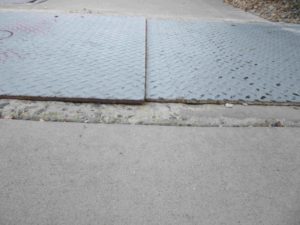
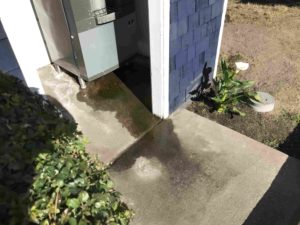
The Flooring, Tile or Surface Itself May be the Cause of the Slip and Fall or Trip and Fall Injury
You do not always need to show that an object was left or substance was spilled on the floor to recover for your slip and fall or trip and fall injuries. In some cases, the actual material used for the floor is too slippery or dangerously slick. For example, if the material used on the floor was polished marble, that was not intended for flooring, that could cause a slip and fall injury.
Flooring surfaces like tile need to provide a certain amount of grip to be safe for use. The scientific term for this is the coefficient of friction. There are industry standards that set forth the acceptable amount of grip the material must provide.
The United States Occupational Safety and Health Administration and Americans With Disabilities Act Accessibility Guidelines both suggest a coefficient of friction of greater than 0.5 on a flat surface. The coefficient of friction must be even higher if the material is on a sloped surface. The same is true for flooring that is an area that is expected to get wet.
How to Test a Slippery Surface for the Coefficient of Friction
An expert can test the coefficient of friction to determine if a surface is too slippery or dangerous. A special machine is used for this purpose. Below are pictures of a machine testing the coefficient friction in a case our law firm handled.
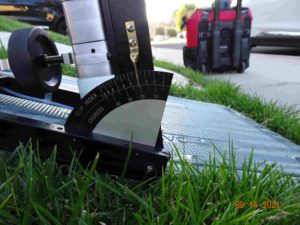
The tests revealed that the surface was dangerously slick. The surface tested was a utility box cover. The utility box caused our client to slip and fall. The client fractured her humerus and required surgery with hardware.
The testing showed that the surface was under the recommended coefficient of friction of 0.5. This was especially dangerous because the surface was also sloped. The surface was sloped at 17 degrees. When a surface is sloped, the coefficient of friction should be even higher and provide greater traction.
An adjacent utility box owned by Verizon showed a coefficient of friction of 0.9. This was almost double the coefficient of friction of the box that our client slipped and fell on. In sum, the utility box our client fell on was a dangerous condition and not up to industry standards. We were able to advance a slip and fall claim on her behalf for her serious injuries.
Steps and Stairs Can Also Cause Slip and Fall and Trip and Fall Injuries
Dangerous steps and stairs can often cause people to fall. This includes stairs that are not maintained properly or have a nose or edging that is deteriorating or slippery. If the stairs do not have a required hand rail this could also lead to a property owner being responsible for the fall. Likewise, steps that are not uniform and that do not comply with building codes can also be a basis to hold someone responsible for damages from a trip and fall injury.
Falls that occur from defective or dangerous stairs can be severe. This is because a person often falls while going down the stairs. As such, the distance that a person may fall is much greater than if someone just fell on a flat or level surface.
A single step may be dangerous as well. This is especially true when the step creates a change in surface elevation that someone is not expecting. This can occur if the change in the elevation or step is not adequately marked. Changes in surface elevation and steps should be adequately marked so people using them can appreciate them. The step or surface should be marked or painted a different color to warn those who use them.
Below is a picture from a real case handled by our Scottsdale trip and fall attorneys. Our client fell due to a hidden step where the change in surface elevations was not adequately marked. After the fall, the property owner painted the step to make it more visible. With our help, the client recovered a significant settlement for her injuries.
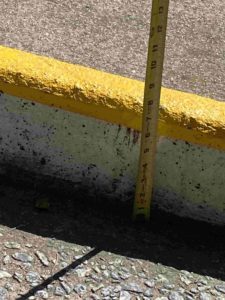
In addition, steps and stairs should be adequately lit at night. If a property does not have steps and stairs illuminated with adequate lighting, it can be a dangerous trap. There are building codes which require steps and stairs to have lighting. If the steps and stairs do not have lighting and a fall occurs at night, the property or land owner may be held responsible for the resulting injuries.
Trip and Fall Injuries and Slip and Fall Injuries Can Be Due to Dangerous Conditions Outside As Well
A trip and fall injury or slip and fall injury does not have to happen inside a store or in a commercial business. These injuries can also happen outside or in outdoor areas. They can be due to negligent maintenance of the property or poor choices in landscaping materials.
Below are pictures of dangerous conditions from two cases our firm handled. The first picture shows a walkway where the surface was not designed or maintained properly. Instead of using a ground cover material of the proper size, the property owner covered the walkway with large rocks that caused out client to fall and break her leg. The client required a surgery with hardware.
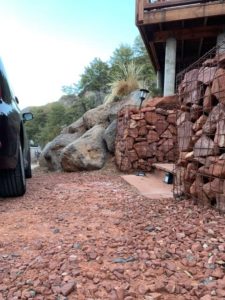
The picture below shows an unfilled section of concrete where a tree had been planted and later removed. After the tree was removed, the area was not filled. This created an uneven surface and trip hazard. Our client fell as a result of the uneven surface and hurt his shoulder. He required a surgery to repair it and we settled with the property owner for a significant amount.
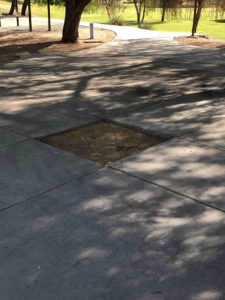
The Injuries Must be Serious to Pursue a Trip and Fall or Slip and Fall Case
As mentioned, slip and fall or trip and fall cases are very difficult to prove. Many members of the public have a misconception that they are frivolous claims. As a result, slip and fall cases are settled out of court for substantially less than other negligence cases. Many times, slip and fall cases require the injured party to present their case to a jury for consideration. Therefore, because there is usually a great deal of work involved with slip and fall cases, attorneys are reluctant to advance them unless the victim’s injuries are serious.
There are two factors to consider when assessing the severity of your injuries. The first, and most obvious, is your economic damages. These types of damages include things such as medical bills, lost wages, prescription costs and other out of pocket expenses resulting from your injuries. The second category of damages is referred to as non-economic damages. These types of damages are difficult to quantify and include things that cannot be purchased. Non-economic damages can include things such as pain, suffering, loss of function of a body part, loss of enjoyment of life and even mental anguish. Typically, the more severe the injury, the greater the resulting non-economic damages will be.
What Types of Injuries Result from Trip and Falls and Slip and Falls?
Some of the most common injuries our Scottsdale slip and fall attorneys see as a result of slip and falls and trip and falls include:
- Broken arms – radius and ulna bones. Bones in the arm are often fractured when the arms are extended to break a fall. This includes tripping forward or slipping backward.
- Broken legs – tibia and fibula bones. Fractures often occur in the lower leg when a trip and fall or slip and fall occurs. The fall causes an overload of weight on the extremity which results in fracture.
- Knee Injuries – patella bone, MCL, ACL, LCL ligaments and meniscus. Serious tendon and ligament injuries can result in the knee when a slip and fall or trip and fall occur. This is due to an over-torquing or twisting of the joint as a result of the fall. Likewise, the patella bone (knee cap) can be fractured due to a forward fall where someone lands on their knee causing an impact fracture.
- Ankle Injuries – talus and malleolus bones, achilles tendon and ankle ligaments. Just like the knee, a fall can cause an overload on the ankle joint causing serious injury. This results when the fall creates forces moving the lower leg in a different direction than the foot and out of acceptable anatomical alignment. When this happens with significant force, fractures, tendon ruptures and ligament tears occur.
- Spinal Injuries – disc herniations, compression fractures of vertebrae and fractures of the coccyx bone. Falls can cause the body to move in an unnatural way. When this occurs, the spine can be compromised and injured. This includes disc herniations and compression fractures of the vertebral bones. The coccyx bone, also know as the tail bone, is located at the bottom of the spine. The coccyx bone is often fractured when some slips backward and lands on his or her tailbone. The fracture is caused by the impact from the fall.
- Head and brain injury – concussions, brain bleeds, skull fractures and traumatic brain injuries. When someone slips and falls backward and hits their head serious injuries and even death may result. Falls can result in significant impact injuries. Impact injuries to the head can cause severe trauma to the skull and brain. These are some of the most sever injuries that can result from a slip and fall. These injuries can be life-changing and cause significant neurological impairment.
- Facial Injuries – injuries to nose, face and mouth. A trip and fall forward can cause someone to land on their face. If a person is unable to break the fall with his or her hands and sustains a direct impact to the face, he or she can fracture his or her nose or orbital (eye socket) bones. In addition, someone can damage their teeth including chipping, fracturing or knocking them out.
If your slip and fall injury involves broken bones, torn ligaments, dental trauma, brain injury, requires surgery or has left you permanently injured, your injuries may warrant brining a claim for damages.
Contact A Scottsdale Slip and Fall Attorney Today If You Were Injured as a Result of a Slip and Fall or Trip and Fall
If you or a loved one suffered a serious injury as a result of a slip and fall or trip and fall, contact Scottsdale Injury Lawyers today. An experienced Scottsdale slip and fall attorney is available now to discuss your case. A consultation is free. There is no retainer to pay or any up-front costs or fees. We only earn a fee if we recover money for you.
About the author: The content on this page was provided by Scottsdale personal injury attorney and civil rights lawyer Tony Piccuta. Piccuta graduated with honors from Indiana University-Maurer School of Law in Bloomington, Indiana (Previously Ranked Top 35 US News & World Report). Piccuta took and passed the State bars of Arizona, California, Illinois and Nevada (all on the first try). He actively practices throughout Arizona and California. He is a trial attorney that regularly handles serious personal injury cases and civil rights lawsuits. He has obtained six and seven figure verdicts in both state and federal court. He has been recognized by Super Lawyers for six years straight. He is a member of the Arizona Association of Justice, Maricopa County Bar Association, Scottsdale Bar Association, American Association for Justice, National Police Accountability Project and Consumer Attorneys of California, among other organizations.
Disclaimer: The information on this web site is for informational purposes only and does not constitute legal advice. The information on this page is attorney advertising. Reading and relying upon the content on this page does not create an attorney-client relationship. If you are seeking legal advice, you should contact our law firm for a free consultation and to discuss your specific case and issues.

